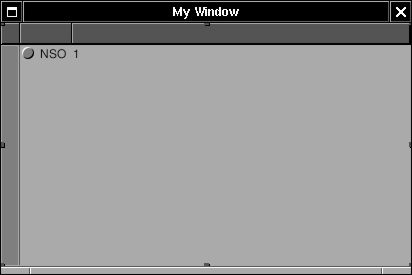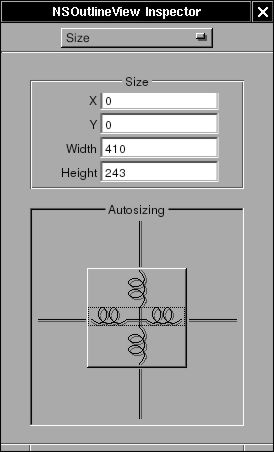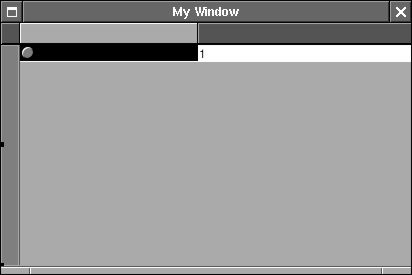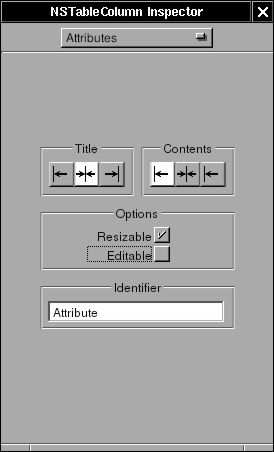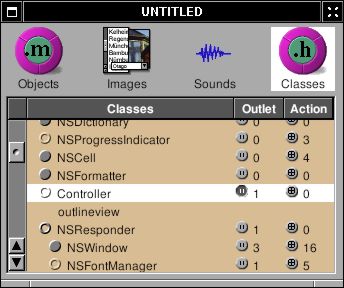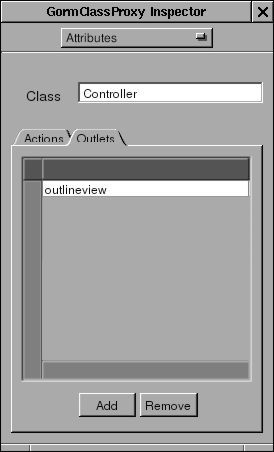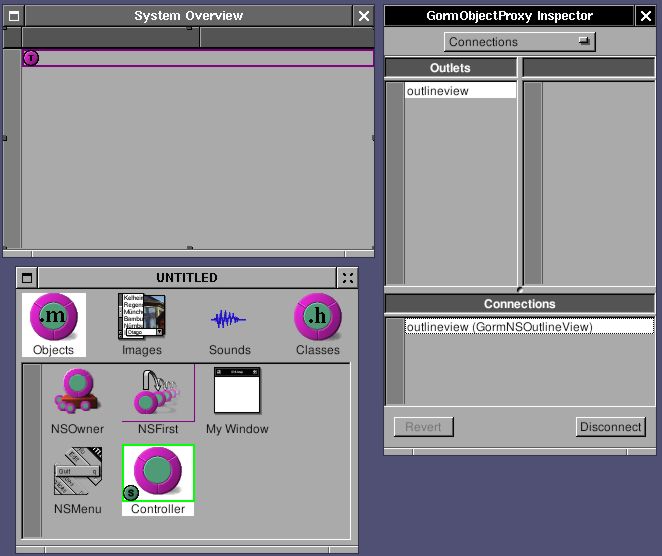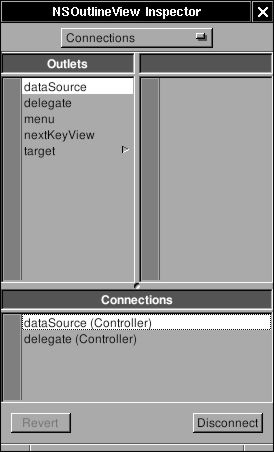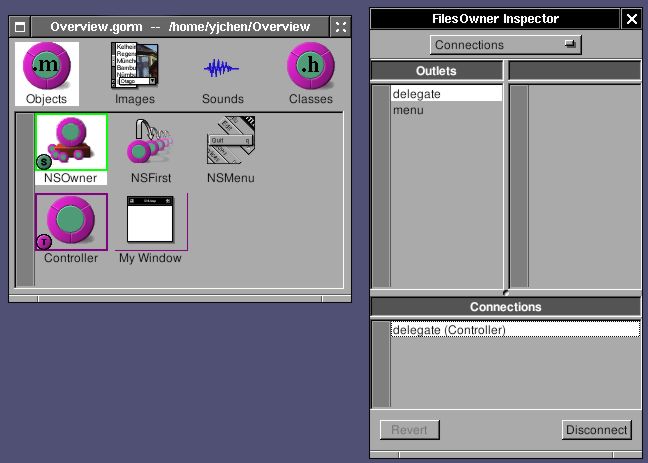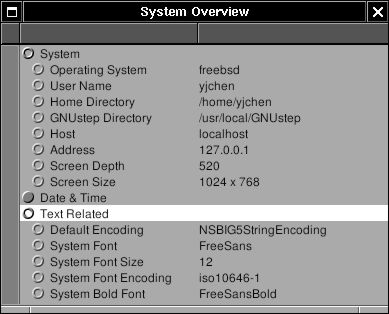NSOutlineView 是 NSTableView 的子類別. 唯一的差別是 NSOutlineView 的資料來源是樹狀結構, 可以展開或關閉, 而 NSTableView 則是使用陣列記錄每一筆資料. 在這裡示範使用 NSOutlineView 顯示系統相關資訊.
使用 Gorm 產生一個新的程式 (New Application). 拖一個 NSOutlineView 到視窗中.
改變 NSOutlineView 的自動改變大小屬性.
在 column 上點兩下以選擇該 column
取消 "Editable" 並將第一個 column 的 identifier 改成 "Attribute", 第二個改成 "Value".
使用者介面完成了. 要製做這個使用者介面的控制者. 繼承自 NSObject, 產生一個 "Controller" 類別.
加入一個 outlet 稱為 "outlineview".
產生 Controller 物件. 將 "outlineview" outlet 連到 NSOutlineView 上. 要確認不是連到 NSScrollView 或 NSTableColumn.
NSOutlineView 是 NSTableView, 因此也必需指定其資料來源 (data source) 及代理者 (delegate). 連結 NSOutlineView 的 dataSource 及 delegate 至 Controller.
最後, 指定 Controller 為 NSApp 的代理者.
將這個使用者介面存成 Overview.gorm 檔. 產生 Controller 的程式碼.
因為 NSOutlineView 的資料是樹狀結構, 在這裡使用很簡單的結點 (Node) 來建立樹狀結構.
Node.h
#ifndef _Overview_Node_
#define _Overview_Node_
#include <Foundation/NSObject.h>
@class NSArray;
@class NSMutableArray;
@class NSString;
@interface Node: NSObject
{
NSString *name;
NSString *value;
NSMutableArray *children;
}
- (void) setName: (NSString *) name;
- (NSString *) name;
- (void) setValue: (NSString *) value;
- (NSString *) value;
- (void) addChild: (id) child;
- (NSArray *) children;
@end
#endif /* _Overview_Node_ */
Node.m
#include "Node.h"
#include <Foundation/Foundation.h>
@implementation Node
- (id) init
{
self = [super init];
children = [NSMutableArray new];
return self;
}
- (void) setName: (NSString *) string
{
ASSIGN(name, string);
}
- (NSString *) name
{
return name;
}
- (void) setValue: (NSString *) string
{
ASSIGN(value, string);
}
- (NSString *) value
{
return value;
}
- (void) addChild: (id) child
{
[children addObject: child];
}
- (NSArray *) children
{
return children;
}
- (void) dealloc
{
RELEASE(name);
RELEASE(value);
RELEASE(children);
[super dealloc];
}
@end
接下來會使用這些結點來建立樹狀結構.
NSTableView 需要這兩個 methods 來顯示資料:
- (int) numberOfRowsInTableView: (NSTableView *) tableView;
- (id) tableView: (NSTableView *) tableView
objectValueForTableColumn: (NSTableColumn *) column
row: (int) row;
因為樹狀資料結構的關係, NSOutlineView 需要四個 methods 來顯示資料:
- (id)outlineView: (NSOutlineView *)outlineView
child: (int)index
ofItem: (id)item;
- (BOOL)outlineView: (NSOutlineView *)outlineView
isItemExpandable: (id)item;
- (int)outlineView: (NSOutlineView *)outlineView
numberOfChildrenOfItem: (id)item;
- (id)outlineView: (NSOutlineView *)outlineView
objectValueForTableColumn:(NSTableColumn *)tableColumn
byItem:(id)item;
"Item" 即為資料結構中的結點, 如果 Item 是 nil, 表示在尋問根結點 (root node). 從根結點開始, NSOutlineView 會尋問每一個結點有多少個子結點, 這個結點是否能展開, 顯示結點的資料, 以及取得所有的子結點. 當 NSOutlineView 尋問過所有節點之後, 所有的資料便顯示出來了.
因此, 要先把樹狀結構建立起來:
Controller.h
/* All Rights reserved */
#include <AppKit/AppKit.h>
@class Node;
@interface Controller : NSObject
{
id outlineview;
Node *root;
}
@end
Controller.m
/* All Rights reserved */
#include <AppKit/AppKit.h>
#include "Controller.h"
#include "Node.h"
@implementation Controller
- (id) init
{
Node *child, *temp;
self = [super init];
root = [Node new];
child = [Node new];
[child setName: @"System"];
/* Add operating system */
temp = [Node new];
[temp setName: @"Operating System"];
[temp setValue: [[NSProcessInfo processInfo] operatingSystemName]];
[child addChild: temp];
RELEASE(temp);
/* Add user name */
temp = [Node new];
[temp setName: @"User Name"];
[temp setValue: NSUserName()];
[child addChild: temp];
RELEASE(temp);
/* Add home directory */
temp = [Node new];
[temp setName: @"Home Directory"];
[temp setValue: NSHomeDirectory()];
[child addChild: temp];
RELEASE(temp);
[root addChild: child];
RELEASE(child);
return self;
}
- (void) dealloc
{
RELEASE(root);
[super dealloc];
}
首先建立根節點, 加上一個 "System" 節點. 再加入三個節點進入 "System" 節點. 這是一個非常簡單的樹狀結構. 有了樹狀結構, 便可以在 NSOutlineView 中顯示出來.
Controller.m
- (id) outlineView: (NSOutlineView *) outlineView
child: (int) index
ofItem: (id) item
{
/* Root */
if (item == nil)
return [[root children] objectAtIndex: index];
/* Others */
if ([[item children] count])
return [[item children] objectAtIndex: index];
else
return nil;
}
- (BOOL) outlineView: (NSOutlineView *) outlineView
isItemExpandable: (id) item
{
/* Root */
if (item == nil)
return YES;
/* Others */
if ([[item children] count])
return YES;
else
return NO;
}
- (int) outlineView: (NSOutlineView *) outlineView
numberOfChildrenOfItem: (id) item
{
/* Root */
if (item == nil)
return [[root children] count];
/* Others */
return [[item children] count];
}
- (id) outlineView: (NSOutlineView *) outlineView
objectValueForTableColumn: (NSTableColumn *) tableColumn
byItem: (id) item
{
if ([[tableColumn identifier] isEqualToString: @"Attribute"])
return [(Node *)item name];
else
return [item value];
}
程式碼很清楚, 只是要特別處理根結點的狀況. 當 item 為 nil 時, 就是尋問根結點的資料.
再完成 main.m 及 GNUmakefile 即可. 程式碼在此: Overview-src.tar.gz
了解如何在 NSOutlineView 中顯示資料後, 便可輕易的加入更多資料.
Controller.m
- (id) init
{
Node *child, *temp;
NSCalendarDate *date;
NSRect frame;
id object;
#define ADD_NAME_VALUE(name, value) \
temp = [Node new]; \
[temp setName: name]; \
[temp setValue: value]; \
[child addChild: temp]; \
RELEASE(temp);
self = [super init];
root = [Node new];
child = [Node new];
[child setName: @"System"];
/* operating system */
ADD_NAME_VALUE(@"Operating System", [[NSProcessInfo processInfo] operatingSystemName]);
/* user name */
ADD_NAME_VALUE(@"User Name", NSUserName());
/* home directory */
ADD_NAME_VALUE(@"Home Directory", NSHomeDirectory());
/* gnustep root directory */
ADD_NAME_VALUE(@"GNUstep Directory", NSOpenStepRootDirectory());
/* host and address */
ADD_NAME_VALUE(@"Host", [[NSHost currentHost] name]);
ADD_NAME_VALUE(@"Address", [[NSHost currentHost] address]);
/* Screen */
ADD_NAME_VALUE(@"Screen Depth", [[NSNumber numberWithInt: [[NSScreen mainScree
n] depth]] description]);
frame = [[NSScreen mainScreen] frame];
object = [NSString stringWithFormat: @"%d x %d", (int)frame.size.width, (int)f
rame.size.height];
ADD_NAME_VALUE(@"Screen Size", object);
[root addChild: child];
RELEASE(child);
child = [Node new];
[child setName: @"Date & Time"];
/* Time Zone */
ADD_NAME_VALUE(@"System Time Zone", [[NSTimeZone systemTimeZone] timeZoneName]
);
ADD_NAME_VALUE(@"Local Time Zone", [[NSTimeZone localTimeZone] timeZoneName]);
/* Date */
date = [NSCalendarDate calendarDate];
[date setCalendarFormat: @"%a, %b %e, %Y"];
ADD_NAME_VALUE(@"Date", [date description]);
[date setCalendarFormat: @"%H : %M : %S"];
ADD_NAME_VALUE(@"Time", [date description]);
[root addChild: child];
RELEASE(child);
child = [Node new];
[child setName: @"Text Related"];
/* default encoding */
ADD_NAME_VALUE(@"Default Encoding", [NSString localizedNameOfStringEncoding: [NSString defaultCStringEncoding]]);
/* Font */
ADD_NAME_VALUE(@"System Font", [[NSFont systemFontOfSize: [NSFont systemFontSize]] displayName]);
ADD_NAME_VALUE(@"System Font Size", [[NSNumber numberWithFloat: [NSFont systemFontSize]] description]);
ADD_NAME_VALUE(@"System Font Encoding", [[NSFont systemFontOfSize: [NSFont systemFontSize]] encodingScheme]);
ADD_NAME_VALUE(@"System Bold Font", [[NSFont boldSystemFontOfSize: [NSFont systemFontSize]] displayName]);
[root addChild: child];
RELEASE(child);
return self;
}
Now, it looks better:
在這個程式中, 當視窗關閉時程式還在. 在這裡使用 NSApp 的代理者來結束程式.
Controller.m
- (BOOL) applicationShouldTerminateAfterLastWindowClosed: (id) sender
{
return YES;
}
